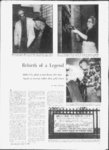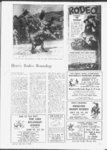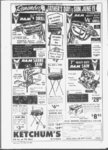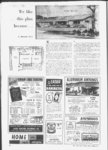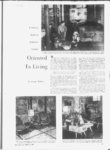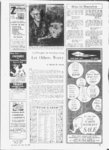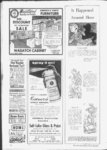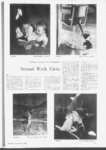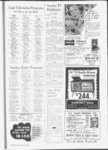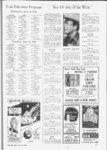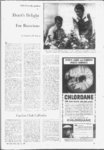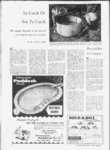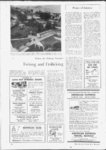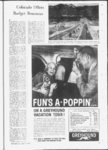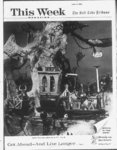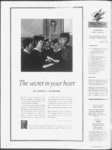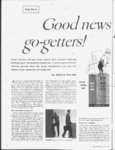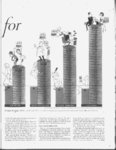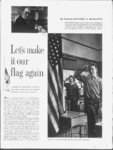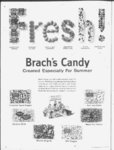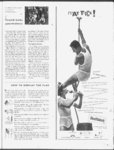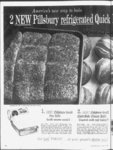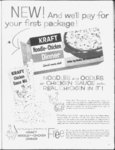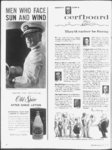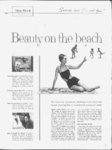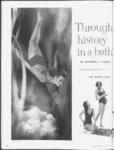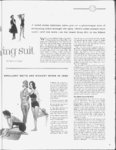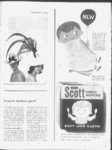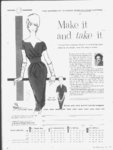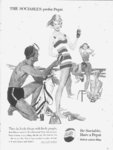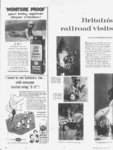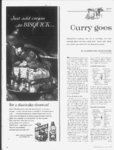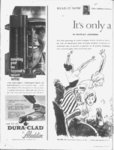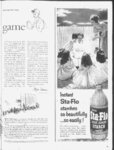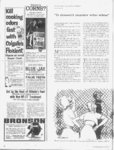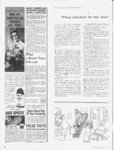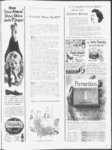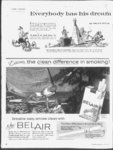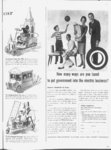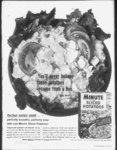| OCR Text |
Show immm PW! 1 ' A sampling of science s How to Measure The Atmosphere by Dr. Robert R. Kadesch I low WOULD YOU like to try measuring the thickness of . our atmosphere? This sounds as if it might be a difficult undertaking, but in reality it is quite simple. The instrument that will do the job is (ailed a nigrometer. You can construct one in a few minutes time. Satellite measurements teU us that our atmosphere extends much farther into space than the several hundred miles previously thought It has even been suggested that the earths atmosphere extends so far as to envelop the moon, some quarter of a million miles away. Our atmosphere is densest at sea level and, as one moves to higher altitudes, it gradually becomes thinner and thinner. ITlE NIGROMETER will not measure this enormously great extension of our atmosphere. What it will do is this: It will measure the thickness our atmosphere would have if all of it were to be compressed into a uniform layer having the same density throughout as the air at the surface of the earth. Secure a cardboard tube about 20 inches long and an inch or so in diameter. Make lids for both ends of the tube. Inch hole in the Make a center of one of these Hds and inch hole in the other. Roll a black paper around each end of the tube which will extend several inches beyond the lids. Before proceeding further, C THE ULLING Ernest CLAS-SIC- Ansermet conducts LOrehestre de la Suisse Romande in a satisfying, comfortably paced performance of Reeth ovens "Pastorale Symphony in one of the weeks best new stereo albums (London). There will be those who prefer the old Toscanini version or the later onps of Walter Klemperer, but Ansermets is bound to pick up a clientele. He achieves the effect of natures spaciousness without falling into the error of over slow tempi. Columbia has issued a new stereo album featuring the St. Louis Symphony under Van Remoortel. It impressed with its vitality and vigor drawn, I suspect, from its energetic and youthful (age 341 conductor. Van Remoortel selected music of Prokofiev for his first recording venture with the St. Louis Symphony. It was a good choice judging from the performcolorful, ances given to the Soviet composers Suite from "Th Love For Three Oranges and Scygood-size- well-define- d d thian Suite. A MORE NOTABLE artistic to Columbias achievement credit is, perhaps, the complete recording of Albenizs Iberia., Considered by many to be the most Important Spanish work for piano, this group of twelve piano pieces is brit 16 lets use the nigrometer in this form to get a clear idea of how it works and what it does. Place the end with the smaller hole toward your eye and look through the tube at your sunny outdoor surroundings'The two holes restrict your view Each color considerably. viewed is seen surrounded by the inky blackness of the in. side of the tube and is free from the influence of adjacent colors in the landscape. Many people notice that colors seem to change when viewed through the nigrometer. NOW DIRECT the tube toward a dark window opening of a home or building some distance away. As dark a background as possible is desired. You will be surprised to notice that a distinct bluish tint is observed through the nigrometer. What you see is light coming into your eye from the direction of the dark window opening. This is sunlight which is scattered in your direction by the air which lies between the dark window and your eye. It is a very small section of v A mailing tube with lids, rolled v iwainnw black paper and a smoked glass are all you need to perform today's - bluesky. Move to a greater distance from the window. The bluish light becomes stronger. Closer to the window the shorter air column will scatter less light into the nigrometer. Now we are ready to measure the thickness of the atmosphere, or more accurately, the thickness of an equivalent uniform layer which contains the same amount of air as the Stoictfy glass will be seen in the upper half. If possible, direct your view so that the sky which is seen in the glass is about 60 degrees from the sun. Move back from the window opening until both halves of the view are equally bright. You will find that the necessary distance is about 300 to 400 yards. What you are doing here is comparing the intensity of light scattered by the entire atmosphere to the intensity scattered by the column of air between you and the window. The glass, however, reflects only about l20th of the light from the sky. This means that the sky light is scattered from a thickness of air above you that is 20 times greater than, the distance between you and the window. thousands of miles of atmosphere over oug heads. YOU. WILL NEED a small piece of clear glass to place in front of the4 nigrometer that will reflect light from the blue sky through the tube. A reflection from the front surface only is desired. This makes it necessary to blacken the back side of the glass. A heavy deposit of soot from the flame of a match will dd. The blackening also serves to cut out light coming directly through the glass. A heavily blackened photographic plate will also do "this job well. Hold the glass at an hngle of about 45 degrees so that it covers just half of the view through the nigrometer. Point the nigrometer at the dark window opening again. Light scattered from the air between you and the window will be seen in the lower half of your field of view. The reflection of blue sky in the Ofcfj FOR EXAMPLE, if you determine that the two halves of your view through the nigrometer are equally bright at a turian3 Rig-nol- d Phil-harmon- ia such Hollywood hits as Over the Sayonara, Rainbow and Love Is A Many Spiendored Thing in his own unique way imaginative (and alive with the usual bongos, bird calls, vibes, marimba, etc.) but always recognizable treatment of these familiar tunes. Design Records has a new compatible fidelity series of records on the market. Available at 1$1.98 they are the first that can be played on both monophonic and stereophonic equipment without record damage. The first one of this type I have auditioned seems to come off fairly well on stereo equipment. It is Ray Eberle Sings and' Plays Music of Today The Glenn Miller Way. It is expected that other recording companies will follow Design's suit to some extent, TWO ALBUMS based on Broadway musicals are available. Best is Epics stereorama disc, Oklahoma; The Rodgers and Hammerstein hit of 1943 remains fresh and enjoyable as Lois Hunt, Stuart Foster and Fay DeWitt sing the best known tunes with orchestral accompaniment The other is Richmond's 51.98 album of the latest R and H hit, The Sound of Music, excerpts of which are performed by the full cast of the London Theater Company. Car-ioc- r oirco by Larry Devine Iiantly and imaginatively performed by the eminent Spanish distaff keyboard artist, Alicia de Larrocha. One of the most brilliant showpieces for piano and orchestra is Khatcha Piano Concerto. It is given a superlative performance by Peter Katin, with Hugo conducting the London Symphony on an Everest release. Sir Malcom Sargent does the music of Handel as well as any conductor of the day. In his latest Capitol album are coupled crisp performances of that master's Water Music and Royal Fireworks Suite arranged by Harty. Also included are Sargents own. arrangement of the overture to SamSon and Elgars arrangement of the D Minor overture. The Royal Philharmonic is the featured (nsemhle. ALSO FROM CAPITOL, (stereo) is an album of ballet music of Schumann and Chopin performed by the under Robert Irving. Although neither com- - distance of 350 yards from the dark window opening, the equivalent thickness of the air above you would be 20 times 350, or 7,000 yards. This is very nearly four miles. If you live a mile and a half above sea leel, this answer would be almost exactly right, for the equivalent thickness of air at sea level is very nearly 51 miles. Dont expect to come closer than'about a mile to the correct answer, however, because there are a number of things which introduce error into this experiment. For one thing, dust in the air can scatter extra light and make the sky appear brighter than it otheri wise would. At any rate, 20 times the distance to the window is the equivalent atmospheric thickness over your head. This distance plus your altitude above sea level should come out to be abyut 52 miles, give or take a mile or so. poser wrote specifically for ballet, some of their piano music lent itself to the dance. The formers Carnaval (as arranged by various Russian composers) and the latters Les Sylphides (arranged by Douglas from selected short piano pieces) are coupled on this disc. Still another tunpful Roman- tic composer, Franz Schubert, is featured on a London stereo disc. The Viennese geniuss Symphony No. 2 and "Unfinished Symphony (No. 8) are beautifully conceived and performed by Karl Munch-inge- r and the Vienna Philharmonic. PICKING THE POPS: This is a week for pops albums rather than jazz. Topping them all is Andre Kostelanetz conducting the New York Philharmonic in a Columbia stereo, Just For Listening. Mr. K. conducts works of Gershwin, Kern and Grofe in arrangements beautifully played by the Philhar-moniMy favorite;, the Kern Medley as arranged by Robert rich-texture- d c. Russell Bennett and including such all time hits as They Ol Man Didn't Believe Me, The Song Is You, River, "Smoke Gets in Your Eyes, and All the Things You are. In the same genre is Columbias Percy Faiths Greatest Hits, which includes such Faith properties (with their typical as the theme from A Summer Place, Moulin Rouge, The Rain in Spain, Syncopated Clock, and others. Rarely have so many of our most popular tunes been available in one album as are found in Everest's (stereo) 101 Hit Songs Lou Stein and His Orchestra. Squeezed on to four sides of two discs are single choruses of nearly every hit in the books. Steins piano is featured throughout: the music has a good beat, and the melody is always to the fore. MARTIN DENNYS latest exotic sounds album is devoted to music From the Silver Screen. This Liberty release finds Denny presenting The Salt Lake Tribune Home Magazine |








































































































